

Gluteal Muscles
What are the Gluteal Muscles?
The Gluteal Muscles comprise three muscles that make up the buttocks: Gluteus Maximus, Gluteus Medius and Gluteus Minimus.
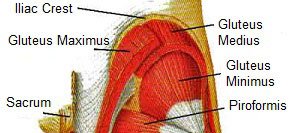
Tortora et al. (1990)[1] describe the function of the gluteal muscles:
- The Gluteus Maximus extends and rotates the thigh laterally.
- The Gluteus Medius and Minimus abduct and rotate the thigh medially.
Are your Gluteal Muscles Weak or Inhibited?
An inhibited muscle means the muscle is not firing correctly (the neural signal is not reaching the muscle). A weak muscle indicates the muscle is firing normally (not inhibited) but lacks strength.
A way to determine if the gluteal muscles are inhibited is to perform a prone hip extension test. To perform this test, lie on a table face down and, keeping a straight leg, lift it off the table. If raising the leg, the knee significantly flexes, or if a "dipping" is noted in the lumbar spine, indicating lumbar extension, the gluteal muscles are inhibited. |
 Hip Extension Test |
Liebenson (2006)[2] states that if a lack of coordination is seen when walking backwards, it indicates a weak gluteus maximus.
What causes weak or inhibited gluteal muscles?
If you spend long periods sitting in a chair, the front of the hips (hip flexors - psoas) become short and tight, while the back (gluteal muscles) become long and weak. Soon the body forgets how to use the gluteal muscles because it will divert the neural signal intended for them to a stronger muscle close by to do the job instead. If the neural system is now asking less powerful muscles to perform the task that requires the gluteal muscles' potential power, then this is likely to lead to injury.
What is the impact of weak or inhibited gluteal muscles?
Weak or inhibited gluteal muscles can result in overactive hamstrings. It can be the reason for low back pain, tight iliotibial bands (ITB syndrome) and patellofemoral pain (runner's knee).
Without a strong gluteus medius to align the femur, knee and ankle, you are likely to overpronate your feet, which can lead to plantar fasciitis (heel pain), Achilles tendinitis and shin splints.
The gluteus medius holds our pelvis upright as we stand. When it gets weak, the piriformis has to compensate. As a result, the piriformis gets bigger and tighter, and you may experience piriformis syndrome.
How will I know if my core muscles are engaged?
Your core engages naturally just before you cough. Try this to get an idea of how it will feel to engage your core.
How can I get my gluteal muscles functioning correctly?
The following exercises will help develop gluteal activation and core stability.
Bridge
|
|
Bridge with leg extension
|
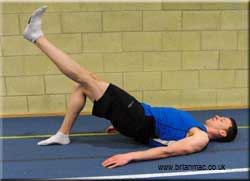 Figure 2 |
Glute Kick
|
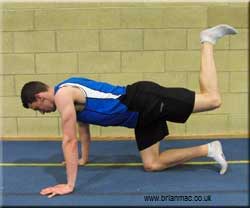 Figure 3 |
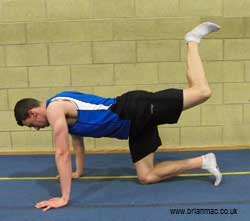 Figure 4 |
|
Leg Lift
|
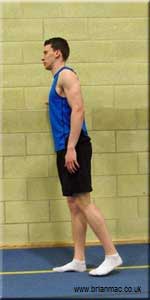 Figure 5 |
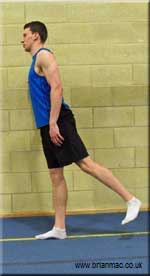 Figure 6 |
|
Lunge
|
 Figure 7 |
Squat
|
 Figure 8 |
Superman
Try to get into a position so that there is a straight line through the arms, neck, back and rear leg. |
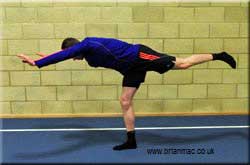 Figure 9 |
What is Piriformis Syndrome?
If you have a short tight Piriformis muscle, you may experience low back pain, pelvic pain, and pain in the buttock or hip. As the piriformis gets bigger, it may trap the sciatic nerve, which can cause numbness and tingling going into your leg or foot; it may hurt to sit, walk or lie down.
Exercise to lengthen the Piriformis
Supine Stretch
|
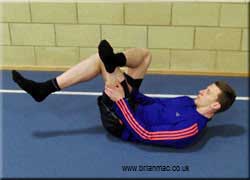 Figure 10 |
What is the impact of a short/tight Psoas?
The rectus femoris acts as a hip flexor and knee extensor. The synergists are the psoas and the tensor fascia latae (TFL). Once the femur reaches about 90 degrees of hip flexion (Figure 11), the psoas takes over because the rectus femoris has shortened and is incapable of applying the necessary force to move the knee above 90 degrees of flexion (Figure 12).
Psoas Test
Stand up tall and maintain a posture to lift one knee past hip height (Figure 12). If your psoas is short/tight, you may experience cramping in the TFL, as your TFL attempts to carry the load, or your hips tilt back as the quadratus lumborum attempts to carry the load.
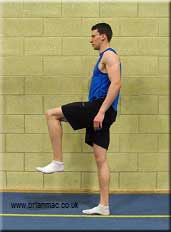 Figure 11 |
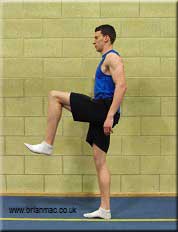 Figure 12 |
Exercise to lengthen the Psoas
Psoas and Quadricep stretch
|
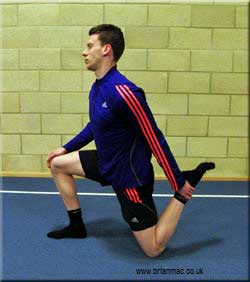 Figure 13 |
and finally
This exercise strengthens your weak hip muscles, glutes and core while challenging your hip flexors.
|
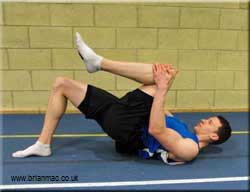 Figure 14 |
How Often?
Suggest the above exercises are performed three times a week with at least 24 hours of recovery between sessions to allow the muscles to adapt.
Best Exercises
Research by Distefano et al. (2009)[3] found that: "The best exercise for the gluteus medius was the side-lying hip abduction, while the single-limb squat and single-limb deadlift exercises led to the greatest activation of the gluteus maximus."
References
- TORTORA, G and ANAGNOSTAKOS, N. (1990) Principles of Anatomy and Physiology. 6th ed. USA; Harper Collins Publishers
- LIEBENSON, C (2006) Rehabilitation of the Spine: A Practitioner's Manual. USA; Lippincott Williams & Wilkins
- DISTEFANO, L. et al. (2009) Gluteal muscle activation during common therapeutic exercises. Journal of orthopaedic & sports physical therapy, 39 (7), p. 532-540
Page Reference
If you quote information from this page in your work, then the reference for this page is:
- MACKENZIE, B. (2012) Gluteus Maximus [WWW] Available from: https://www.brianmac.co.uk/glutes.htm [Accessed
